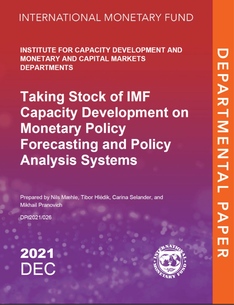IMF Departmental Paper on the efficient design of monetary policy forecasting and policy analysis systems
February 14, 2022
The Institute for Capacity Development and the Monetary and Capital Markets Department of the International Monetary Fund (IMF) published a departmental paper in December 2021 entitled Taking stock of IMF capacity development on monetary policy forecasting and policy analysis systems. With my co-authors Nils Mæhle, Carina Selander, and Mikhail Pranovich, we took stock of the capacity development (CD) projects focused on Forecasting and Policy Analysis System (FPAS) offered by the IMF, drawing extensively on the experience gained while developing FPAS capacity in central banks. The paper aims at facilitating the understanding of FPAS CD within and outside of the IMF and informing on how to build policy-oriented macroeconomic frameworks effectively. As such, the paper offers a qualitative assessment of the experience with FPAS CD delivery and its use in monetary policy decision-making.
The first analytic chapter of the paper presents the main design features that any FPAS should satisfy. Interest rate decisions or setting alternative policy instruments require a good understanding of the economic conditions at the time of the policy meeting, factors affecting the attainment of the objective over the policy horizon and the monetary policy transmission. Therefore, all central banks with some degree of monetary policy autonomy need an FPAS. After identifying the key requirements that forecasting systems should satisfy, the paper discusses the scope of CD activities that are needed for developing a well-functioning FPAS. Besides model development, which is always at the center of any CD project, they include areas such as staffing, data management and internal and external communication.
The next chapter summarizes the modeling experience accumulated by experts while delivering CD projects in heterogenous economies. Country-specific features, important for the identification of the monetary transmission channels, are described in detail, including corresponding modeling choices. The range of issues covered is extensive: sectoral analysis, near-term forecasting tools as well as the specification of the basic “textbook” version of the workhorse quarterly projection model (QPM). The latter forms the backbone of FPAS. Important extensions of the prototype model are introduced. They are real life examples of the extensions of the core model with country-specific economic characteristics, including a fiscal policy block, incorporation of terms of trade effects, or more detailed modeling of the interest rate transmission channel. The paper also captures the heterogeneity in terms of alternative or “hybrid” policy regimes, including money targeting, limited foreign exchange market arbitrage and pegged- or managed exchange rate regimes. Issues related to the calibration of the QPM will surely be appreciated by practitioners who are responsible for keeping their forecasting tools up-to date.
The next part brings the hands-on experience gained during CD projects with the forecasting process and incorporation of FPAS into the decision-making process, thus complementing the previous, rather technical part of the paper. It formulates the best practices not only in terms of organizing internal forecasting meetings and making internal communication effective, but also touches upon staffing and some managerial aspects related to sustainable and effective organization of forecasting and policy analysis in central banks.
The paper concludes with an assessment of the discussed CD projects, as well as lessons drawn from experience. The review of CD projects revealed that central banks that were able to successfully absorb CD assistance were able to enhance their internal organization, the policy formulation processes, and external monetary policy communication. They implemented a well-structured policy decision-making process, and this experience changed the way they think about monetary policy decision-making and analysis. Institutions where challenges related to the full-fledged implementation of FPAS remain were also identified. Those challenges include, for instance, weaker analytical capacity, somewhat erratic policy implementation and lower institutional support for establishing a functioning FPAS. Nevertheless, many of these countries still made important progress that might provide the foundation for further improvements in the future.
The experience with FPAS CD included into the paper suggests several important lessons. They concern planning of the CD project, ensuring the commitment of the staff and management, developing modeling tools, establishing processes in line with sound internal communication principles, training staff, and incentivizing human resource management.
Tibor Hlédik, Lead Economist, Joint Vienna Institute










